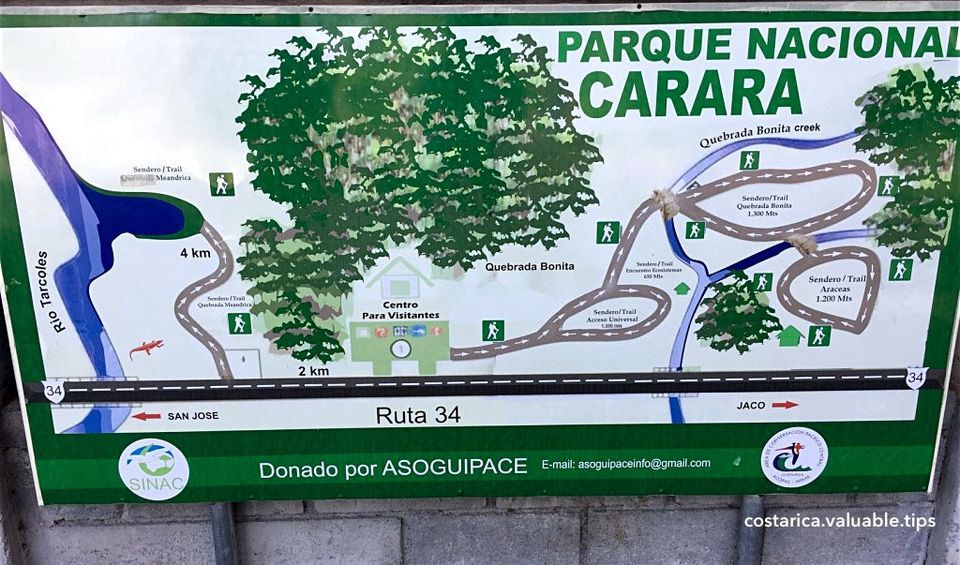Carara National Park is one of Costa Rica’s 28 national parks. It is was established as a biological reserve in 1978, but as of 1998 has been upgraded to a category of national park. The park is not as popular as many others in Costa Rica, but features an excellent experience of some of the most magnificent types of rainforests and plant life. It includes some wetlands, as it protects the river basin of the Tárcoles River, and includes one of the largest remaining populations of wild scarlet macaws in Costa Rica.
Getting There
Carara National Park is located on the mid-Pacific coast in the province of Puntarenas, which makes up a large portion of western Costa Rica. It is very easy to access, as it sits directly on the coastal route 34 (Carretera Pacifica Fernandez Oreamuno — Costanera Sur). Coastal route 34 is an easy drive, which consists of a one-lane highway.
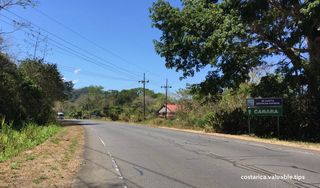
It is roughly:
- 77 km from the capital of San Jose
- 47 km from Punta Arenas
- 20 km from Jaco
- 93 km from Quepos
- 150 km from Uvita
You can get there by:
Car: Official parking is available at the park. It is free and there is a large lot directly off of the highway for the main park entrance, and a small parking area at the Laguna Meandrica trailhead.
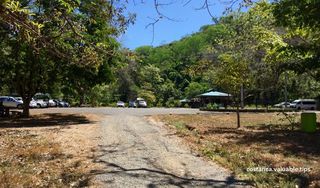
Bus: There are many bus options to get to Carara National Park.
From San Jose, you can take a non-direct (colectivo) bus from Tracopa / Transportes Delio Morales (bright pink or green) heading to Quepos or Manuel Antonio Park. These depart several times a day; check schedule at the station for most up to date info.
From San Jose, Orotina, or Jaco, you can take a non-direct (colectivo) bus from Garabito / Transportes Jaco (white with yellow-orange markings) heading to Jaco (if from San Jose and Orotina) or to San Jose or Orotina (if from Jaco). These depart several times a day; check schedule at the station for most up to date info.
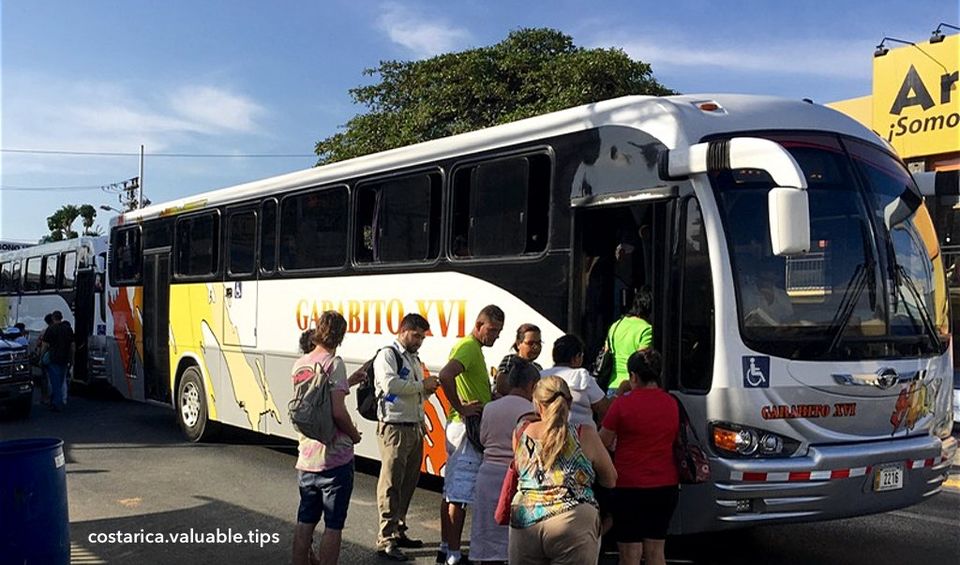
- From Puntarenas, Jaco, Esterillos area or Quepos, you can take a bus from TQP / Transportes Quepos Puntarenas (lime green), which goes along route 34, making all stops as needed, roughly every hour.
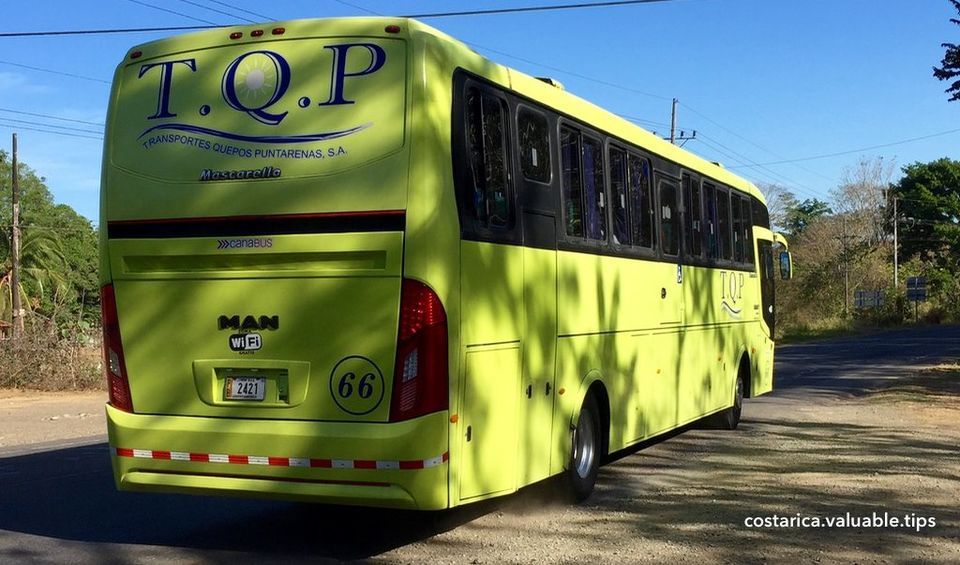
Shuttles, Tours & Taxis: You can get a taxi or arrange transportation through your hotel, or purchase a tour package, which will take you to the park.
Best Time to Visit
Carara National Park is open Monday through Sunday, from 7am to 4pm during December through April, and open from 8am to 4pm from May through November. This is not a very busy park, so almost any day is good to visit, however like everywhere else weekends will be the busiest.
For greatest chance of animal sightings, it is best to visit very early in the morning or as late in the afternoon as possible.
Entrance Fee and Payment Options
The cost of admission to Carara National Park for visitors to Costa Rica is currently $10 USD. You can also pay in Costa Rican colones, and the park charges the price in colones based on the rate of conversion from USD, which currently works out to be around 5,600 CRC.
You can pay by cash or credit card.
The park does not offer any discounted multi-day or monthly passes.
Buying Tickets
Tickets are purchased at the main park entrance, right off of route 34. There is a park ranger building where you can find the park map, buy tickets and get info. There are usually some guides present there as well, for those who wish to hire a guide for the park.
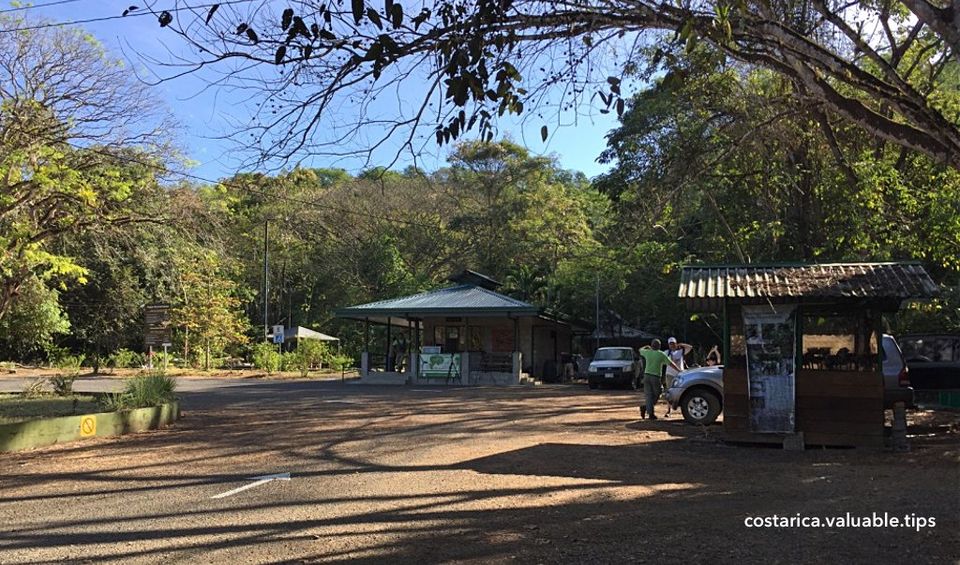
Note, there is no option to purchase tickets at the trail head of the Laguna Meandrica, which is located about 2 km north from the main entrance, right off the highway.
Hiring a Guide
Whether you should explore the park on your own or hire a guide will depend on your preferences and desires.
- If you are an independent nature enthusiast, you will most likely not want or need a guide, but prefer to explore the park on your own. All the trails and areas are easily marked, and there are some educational boards along the trails with images and information about some of the plants and animals.
- If you want to have someone spot animals for you, show you them up close via a telescope and teach you a bit about the biology and ecology of the park’s plants and animals, then you will most likely want to hire a guide. Guide prices range depending on group size, time required, etc.
What to Bring
What you will need to bring will depend on how long you are planning on staying in the park and on your or your group’s particular needs. In general, you should bring:
- Water. Bring enough water with you for your trip. There are no specific water stations at the park, aside from the bathroom facilities present at the park entrance and on the Universal trail, which may not be a desirable option.
- Food. Bring enough food with you for your trip. There are no options to purchase any food at the park.
- Proper sun cover. Although most of the trails have ample shade thanks to the dense canopy above, it is best to be properly prepared for any sun exposure by having a hat, sunglasses, and natural sunscreen.
- Proper insect cover. Depending on the time of year of your visit, the insects at the park, including mosquitoes, will range from minimal to abundant. Light, loose, long-sleeved clothing is always recommended and/or a safe and effective insect repellent.
- Camera, to take photos and/or video of your trip.
- Binoculars or telescope, if you want to get a better view of plants and animals.
What Not to Bring
- Beach or camping gear. This park does NOT have any swimming areas or overnight camping accommodations.
- Anything that will generate a large amount of garbage.
- Anything that would pose a danger to the environment, animals or other visitors.
How to Dress
As most parts of Costa Rica, Carara National Park has a very hot climate, which can also be quite humid. While shorts and t-shirts or tank tops would be best, you should consider light, loose and long-sleeved clothing as an appropriate insect and sun protection cover.
The trails are almost all fully flat, with only a small amount of stairs, and vary between fully paved to fully natural. The paved part can be done in any reasonable footwear, however closed footwear, such as running shoes or sneakers are best and highly recommended for proper safety and comfort.
What to do There
- Walk / hike
- Bird and animal watch
- Nature photography
- Relax
- Meditate
Eating at the Park
The park does not sell any food or drinks. You can bring your own food and drinks, if needed, depending on how long you plan on staying at the park.
At the park entrance and on the Universal trail there are some benches for sitting. There are no tables or specific picnic areas in the park at this time.
Park Trails
Carara National Park has 4 main trails that range in length from about 1.2km (0.75 miles) to 4km (2.5 miles). In total however, one can complete over 16km (10 miles) of walking. As shared above, the trails are quite flat and easy to traverse. All of the park trails can be done within a few hours or half of the day, in a semi-relaxed manner.
A big board with the park map (as seen below) is present at the park entrance. Paper maps are not provided, and visitors can simply snap a photo of the map upon arrival.
The Universal trail is the first of the three main loop trails, accessible directly from the park entrance. This trail is fully paved and suitable for small children, strollers and wheelchairs. This trail has some benches along its path and bathroom facilities.
The Quebrada Bonita trail is the second of the three main loop trails, accessible from the Universal trail. The path is mostly natural terrain, with just a few stairs, and a bridge crossing. The creek has minimal water during the dry season. This trail does not have any benches or bathrooms.
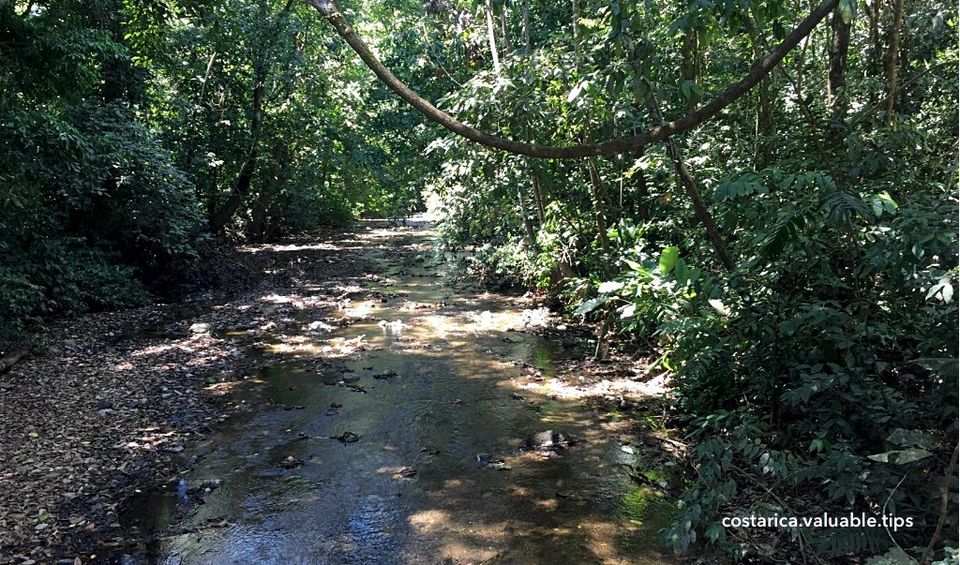
The Araceas trail is the third and last of the three main loop trails. The path is mostly natural terrain, and also has a bridge, which was damaged and unaccessible at the time of publishing this post. An alternate path was available through the dry creek bed.
The Laguna Meandrica trail is located about 2km north of the park entrance, away from all the other trails. You can access it directly from the highway (route 34) by foot or by car, and it has a small parking area.
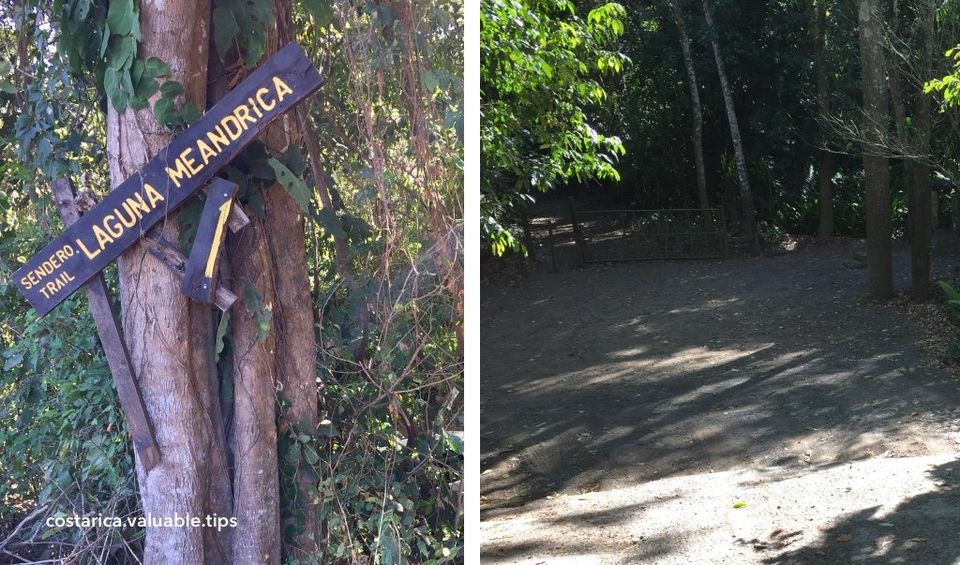
It is a wilder trail, with a fully natural terrain, which varies in width, from small group comfort to single file walking. Parts of the trail also have some forest detours, due to fallen trees. Although the park map shows this as a single, dead-end path, where you need to return the same way you came, there is actually a minor trail that forks off and allows you to loop back about three-quarters of the way in, or proceed to the end, and return for part of the trail on the minor path. (You may be able to see it on your smartphone map.)
The plant life on this trail differs from the other trails, in that it includes wild flowers, wild banana and plantain trees, less dense canopy cover, as well as grasses of the lagoon wetlands. This trail does not have any benches or bathrooms. This trail is closed during September and October due to flooding and crocodile risk.
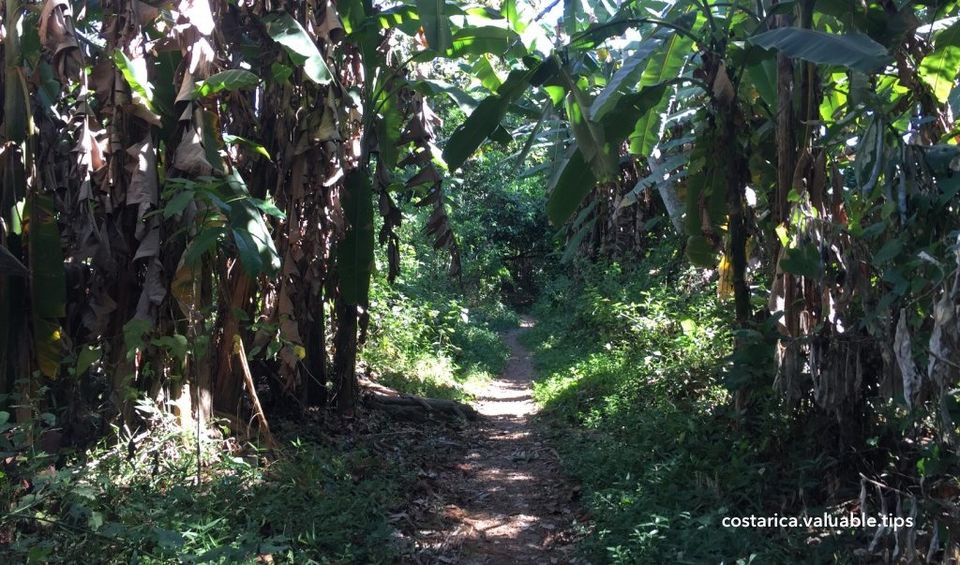
Wildlife
The Carara Park area is home to an abundant variety of insects, reptiles, birds and mammals. However, much of this park includes extremely tall trees and dense canopies, which limit the amount of animal sightings. Sightings will also vary based on season, month and time of day.
You are pretty much guaranteed to see some birds and iguanas or other lizards. You also have the chance of seeing some monkeys, like the white-faced Capuchins, the Agouti, Coati, Sloth, snakes and big birds like the Macaws and the Great Tinamou.
Safety and Precautions
- There are crocodiles in the area, specifically nearby at Tarcoles River. Do not go near any bodies of water.
- There are various snakes in the area. They will usually be active at night, but stay alert and take appropriate precautions.
- Do not feed any animals. It can harm them and create problematic behavior.
- Stay on the trails.
- Stay hydrated.
- Be sun smart to avoid burning or heat stroke.
- Be mindful of the terrain while walking to avoid slips or sprains.
- Do not leave any belongings or valuables unattended, especially in your car in the parking lot.
Summary
Despite its large size, the park is small based on what the trails alone can provide. Many people come for half a day or less to do some walking and/or wildlife watching. The plant life is stunning and provides for an excellent experience of comfortably hiking through a jungle-like rainforest. As with all wild areas in nature, the more time you spend there, and the more in tune you are with the environment, the higher are your chances of animal sightings.
Always stay mindful and observant to have a safe, fun and enjoyable time, and be considerate of the environment, wildlife and other visitors. Wishing you a great time!

